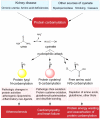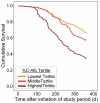Protein carbamylation in kidney disease: pathogenesis and clinical implications
- PMID: 25037561
- PMCID: PMC4209336
- DOI: 10.1053/j.ajkd.2014.04.034
Protein carbamylation in kidney disease: pathogenesis and clinical implications
Abstract
Carbamylation describes a nonenzymatic posttranslational protein modification mediated by cyanate, a dissociation product of urea. When kidney function declines and urea accumulates, the burden of carbamylation naturally increases. Free amino acids may protect proteins from carbamylation, and protein carbamylation has been shown to increase in uremic patients with amino acid deficiencies. Carbamylation reactions are capable of altering the structure and functional properties of certain proteins and have been implicated directly in the underlying mechanisms of various disease conditions. A broad range of studies has demonstrated how the irreversible binding of urea-derived cyanate to proteins in the human body causes inappropriate cellular responses leading to adverse outcomes such as accelerated atherosclerosis and inflammation. Given carbamylation's relationship to urea and the evidence that it contributes to disease pathogenesis, measurements of carbamylated proteins may serve as useful quantitative biomarkers of time-averaged urea concentrations while also offering risk assessment in patients with kidney disease. Moreover, the link between carbamylated proteins and disease pathophysiology creates an enticing therapeutic target for reducing the rate of carbamylation. This article reviews the biochemistry of the carbamylation reaction, its role in specific diseases, and the potential diagnostic and therapeutic implications of these findings based on recent advances.
Keywords: Carbamylation; carbamoylation; chronic kidney disease (CKD); cyanate; end-stage renal disease (ESRD); inflammation; pathophysiology; posttranslational protein modification (PTM); urea; uremia.
Copyright © 2014 National Kidney Foundation, Inc. Published by Elsevier Inc. All rights reserved.
Figures


References
-
- Wöhler F. Ueber künstliche Bildung des Harnstoffs. Ann Phys. 1828;87:253–6.
-
- Walker J, Hambly FJ. Transformation of ammonium cyanate into urea. J Chem Soc. 1895;67:746–67.
-
- Shutz F. Cyanate. Experientia. 1949;5:133–72. - PubMed
Publication types
MeSH terms
Substances
Grants and funding
LinkOut - more resources
Full Text Sources
Other Literature Sources
Medical

